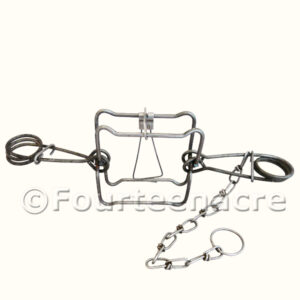This article originally appeared in the Countryman’s Weekly, 1st July 2015.
 One of the modern trapping mysteries, which I had never been able to pin down, is the exact UK legal status of the Conibear 120-2. While there have always been people who were adamant it was fine for use in the UK, it has never been listed on any version of the Spring Traps Approval Order. After trawling through the DEFRA internet archives and an email exchange with Natural England, I am now able to give a definitive answer. What’s more, I can explain where the confusion has come from.
One of the modern trapping mysteries, which I had never been able to pin down, is the exact UK legal status of the Conibear 120-2. While there have always been people who were adamant it was fine for use in the UK, it has never been listed on any version of the Spring Traps Approval Order. After trawling through the DEFRA internet archives and an email exchange with Natural England, I am now able to give a definitive answer. What’s more, I can explain where the confusion has come from.
So let’s start with the basics. The term ‘Spring Trap’ is officially used to describe any type of killing trap which is powered by a spring; from the everyday mousetrap to the powerful Kania 2000. The rules governing use of spring traps are actually pretty straightforward but, typically, the regulations involve several layers of legislation to get there. The Pests Act 1954 makes it is an offence to use, (or permit the use of), any spring trap, other than an approved trap. It also makes it an offence to use an approved trap in an unapproved way. The Small Ground Vermin Traps Order 1958 then goes on to exempt (i) spring traps known as break-back traps for destruction of rats and mice and (ii) spring traps of a kind commonly used for catching moles in their runs.
The Spring Traps Approval Order (STAO) is where we start to get down to the detail of what can be used and how. It was first introduced in 1957 and has been updated frequently since then. At present the authorities in England, Wales, Scotland and Northern Ireland all publish their own version of the Approval Order and the current Orders are easily available on the internet.
In simple terms if a trap is not listed on the STAO then it’s not legal to use – with the exception of one condition. In 1995 a new and updated release of the STAO included an amendment to allow equivalent or ‘clone’ traps to be used in place of those from the named manufacturers.
In 1997 DEFRA took the unusual and never repeated step of specifically naming 3 clone traps in a press release; the Payne Mark I, the Victor Conibear 110-2 and the Victor Conibear 120-2. These three traps became unique in being officially recognised by DEFRA but NOT included in the Order or any other legislative documents.
Shortly afterwards the DEFRA website was updated to contain a complete, alphabetical list of traps which were described as ‘Approved’. At the top of that page was the paragraph;
“Traps that are currently approved are specified in the The Spring Traps Approval Order 1995 (Statutory Instrument 1995 No. 2427). In 1997 this list was amended to include clones of types approved under the 1995 Order. A revised list, including these clones, is given in the table below:”
Crucially, the list included the three named clones as stated but they were mixed in with, and indistinguishable from, those traps which were specifically named on the order.
You can see a copy of that website page for yourself here, in an archive copy of the 2003 website.
In September 2007, the next variation to the STAO was published to add a few new traps. For simplicity the DEFRA website was changed so that it no longer contained the detailed breakdown of Approved Traps. This was clearly a practical decision which removed the need for DEFRA to keep the website in step with detail of the order. Instead the new web page simply referred any readers wanting more detail to the STAO itself, via a link.
Unfortunately this change removed any formal recognition of the Conibear traps from public record. The website referenced the STAO and the STAO has never endorsed any named ‘clone’ traps. From this point on it became impossible for any member of the public to independently verify the status of the Conibear traps.
The position today is that I would advise anyone to ONLY use the traps specifically listed on the STAO in your region.
So what does this mean for other bodygrip style traps? Well it’s important to remember that these three are the only traps to ever be officially recognised as suitable ‘clones’. The conditions laid down for determining a suitable clone are fairly rigorous:
a spring trap is equivalent in all relevant respects to a spring trap of a type and make specified in the Schedule if it corresponds to the spring trap so specified in construction, in materials, in impact force or momentum, and in all other respects which are relevant to its effect or manner of operation as a trap.
Remember that it would be your responsibility to ensure that any non-listed traps that you used were truly equivalent and satisfied the ‘clone’ condition. Knowing that similar traps from other manufacturers have been submitted for approval and have failed, I doubt that true equivalence is as likely as you might think. My advice would usually be to stick the traps named on the STAO but perhaps in the case of the Conibear we can all make an exception. But watch your fingers – as a double spring trap it’s more difficult and more dangerous to use.